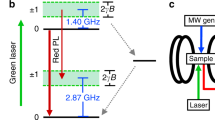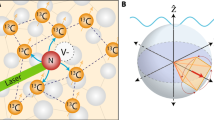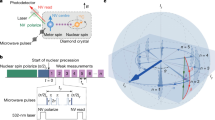Abstract
Magnetic resonance techniques not only provide powerful imaging tools that have revolutionized medicine, but they have a wide spectrum of applications in other fields of science such as biology, chemistry, neuroscience and physics. However, current state-of-the-art magnetometers are unable to detect a single nuclear spin unless the tip-to-sample separation is made sufficiently small. Here, we demonstrate theoretically that by placing a ferromagnetic particle between a nitrogen–vacancy magnetometer and a target spin, the magnetometer sensitivity is improved dramatically. Using materials and techniques that are already experimentally available, our proposed set-up is sensitive enough to detect a single nuclear spin within ten milliseconds of data acquisition at room temperature. The sensitivity is practically unchanged when the ferromagnet surface to the target spin separation is smaller than the ferromagnet lateral dimensions; typically about a tenth of a micrometre. This scheme further benefits when used for nitrogen–vacancy ensemble measurements, enhancing sensitivity by an additional three orders of magnitude.
This is a preview of subscription content, access via your institution
Access options
Subscribe to this journal
Receive 12 print issues and online access
$259.00 per year
only $21.58 per issue
Buy this article
- Purchase on Springer Link
- Instant access to full article PDF
Prices may be subject to local taxes which are calculated during checkout




Similar content being viewed by others
References
Ramsden, E. Hall-Effect Sensors 2nd edn (Newnes, 2006).
Huber, M. E. et al. Gradiometric micro-squid susceptometer for scanning measurements of mesoscopic samples. Rev. Sci. Instrum. 79 ( 2008).
Degen, C. L., Poggio, M., Mamin, H. J., Rettner, C. T. & Rugar, D. Nanoscale magnetic resonance imaging. Proc. Natl Acad. Sci. USA 106, 1313–1317 (2009).
Poggio, M. & Degen, C. L. Force-detected nuclear magnetic resonance: recent advances and future challenges. Nanotechnology 21, 342001 (2010).
Peddibhotla, P. et al. Harnessing nuclear spin polarization fluctuations in a semiconductor nanowire. Nature Phys. 9, 631–635 (2013).
Mamin, H. J. et al. Nanoscale nuclear magnetic resonance with a nitrogen-vacancy spin sensor. Science 339, 557–560 (2013).
Grinolds, M. S. et al. Subnanometre resolution in three-dimensional magnetic resonance imaging of individual dark spins. Nature Nanotech. 9, 279–284 (2014).
Staudacher, T. et al. Nuclear magnetic resonance spectroscopy on a (5-nanometer)3 sample volume. Science 339, 561–563 (2013).
Rondin, L. et al. Magnetometry with nitrogen-vacancy defects in diamond. Rep. Prog. Phys. 77, 056503 (2014).
Waldherr, G. et al. High-dynamic-range magnetometry with a single nuclear spin in diamond. Nature Nanotech. 7, 105–108 (2012).
Bassett, L. C. et al. Ultrafast optical control of orbital and spin dynamics in a solid-state defect. Science 345, 1333–1337 (2014).
Maletinsky, P. et al. A robust scanning diamond sensor for nanoscale imaging with single nitrogen-vacancy centres. Nature Nanotech. 7, 320–324 (2012).
Sushkov, A. O. et al. Magnetic resonance detection of individual proton spins using quantum reporters. Phys. Rev. Lett. 113, 197601 (2014).
Loretz, M., Pezzagna, S., Meijer, J. & Degen, C. L. Nanoscale nuclear magnetic resonance with a 1.9-nm-deep nitrogen-vacancy sensor. Appl. Phys. Lett. 104 ( 2014).
Schaffry, M., Gauger, E. M., Morton, J. J. L. & Benjamin, S. C. Proposed spin amplification for magnetic sensors employing crystal defects. Phys. Rev. Lett. 107, 207210 (2011).
van der Sar, T ., Casola, F., Walsworth, R. & Yacoby, A. Nanometre-scale probing of spin waves using single electron spins. Preprint at http://arXiv.org/abs/1410.6423 (2014).
Wolfe, C. S. et al. Off-resonant manipulation of spins in diamond via precessing magnetization of a proximal ferromagnet. Phys. Rev. B 89, 180406 (2014).
Fuchs, G. D., Burkard, G., Klimov, P. V. & Awschalom, D. D. A quantum memory intrinsic to single nitrogen-vacancy centres in diamond. Nature Phys. 7, 789–793 (2011).
Stoner, E. C. & Wohlfarth, E. P. A mechanism of magnetic hysteresis in heterogeneous alloys. Phil. Trans. R. Soc. Lond. A 240, 599–642 (1948).
Trifunovic, L., Pedrocchi, F. L. & Loss, D. Long-distance entanglement of spin qubits via ferromagnet. Phys. Rev. X 3, 041023 (2013).
Cywiáski, Å., Lutchyn, R. M., Nave, C. P. & Das Sarma, S. How to enhance dephasing time in superconducting qubits. Phys. Rev. B 77, 174509 (2008).
De Lange, G., Wang, Z. H., Rista, D., Dobrovitski, V. V. & Hanson, R. Universal dynamical decoupling of a single solid-state spin from a spin bath. Science 330, 60–63 (2010).
Acosta, V. M. et al. Diamonds with a high density of nitrogen-vacancy centers for magnetometry applications. Phys. Rev. B 80, 115202 (2009).
Ohno, K. et al. Engineering shallow spins in diamond with nitrogen delta-doping. Appl. Phys. Lett. 101, 082413 (2012).
Myers, B. A. et al. Probing surface noise with depth-calibrated spins in diamond. Phys. Rev. Lett. 113, 027602 (2014).
Puentes, G., Waldherr, G., Neumann, P., Balasubramanian, G. & Wrachtrup, J. Efficient route to high-bandwidth nanoscale magnetometry using single spins in diamond. Sci. Rep. 4, 4677 (2014).
London, P., Balasubramanian, P., Naydenov, B., McGuinness, L. P. & Jelezko, F. Strong driving of a single spin using arbitrarily polarized fields. Phys. Rev. A 90, 012302 (2014).
Fuchs, G. D., Dobrovitski, V. V., Toyli, D. M., Heremans, F. J. & Awschalom, D. D. Gigahertz dynamics of a strongly driven single quantum spin. Science 326, 1520–1522 (2009).
Yoneda, J. et al. Fast electrical control of single electron spins in quantum dots with vanishing influence from nuclear spins. Phys. Rev. Lett. 113, 267601 (2014).
Schryer, N. L. & Walker, L. R. The motion of 180 domain walls in uniform dc magnetic fields. J. Appl. Phys. 45, 5406 (1974).
Balasubramanian, G. et al. Ultralong spin coherence time in isotopically engineered diamond. Nature Mater. 8, 383–387 (2009).
Tetienne, J-P. et al. Magnetic-field-dependent photodynamics of single NV defects in diamond: an application to qualitative all-optical magnetic imaging. New J. Phys. 14, 103033 (2012).
Schäfer-Nolte, E. et al. Tracking temperature dependent relaxation times of individual ferritin nanomagnets with a wide-band quantum spectrometer. Preprint at http://arXiv.org/abs/1406.0362 (2014).
Schäfer-Nolte, E. et al. Tracking temperature-dependent relaxation times of ferritin nanomagnets with a wideband quantum spectrometer. Phys. Rev. Lett. 113, 217204 (2014).
Smith, D. O. Static and dynamic behavior of thin permalloy films. J. Appl. Phys. 29, 264–273 (1958).
Lotze, J., Huebl, H., Gross, R. & Goennenwein, S. T. B. Spin Hall magnetoimpedance. Phys. Rev. B 90, 174419 (2014).
Julliere, M. Tunneling between ferromagnetic films. Phys. Lett. A 54, 225–226 (1975).
Lee, K-J., Deac, A., Redon, O., Nozieres, J-P. & Dieny, B. Excitations of incoherent spin-waves due to spin-transfer torque. Nature Mater. 3, 877–881 (2004).
Teissier, J., Barfuss, A., Appel, P., Neu, E. & Maletinsky, P. Strain coupling of a nitrogen-vacancy center spin to a diamond mechanical oscillator. Phys. Rev. Lett. 113, 020503 (2014).
Aharoni, A. Introduction to the Theory of Ferromagnetism 2nd edn (Oxford Univ. Press, 2001).
Samofalov, V. N., Belozorov, D. P. & Ravlik, A. G. Strong stray fields in systems of giant magnetic anisotropy magnets. Physics-Uspekhi 56, 269 (2013).
Acknowledgements
The authors thank H. Fanghor for sharing his expertise about micromagnetic simulations. This work was supported by the Swiss National Science Foundation, the National Centre of Competence in Research, Quantum Science and Technology, Diamond Devices Enabled Metrology and Sensing, Intelligence Advanced Research Projects Activity, the Defense Advanced Research Projects Agency, Quantum-Assisted Sensing and Readout programmes and the Multidisciplinary University Research Initiative, Qubit Enabled Imaging, Sensing, and Metrology. F.L.P. acknowledges support from the Alexander von Humboldt Foundation.
Author information
Authors and Affiliations
Contributions
L.T. and F.P. performed the calculations and numerical simulations. L.T. and D.L. were responsible for the project planning. All the authors contributed to the discussions and writing. D.L. initiated and supervised the work.
Corresponding author
Ethics declarations
Competing interests
The authors declare no competing financial interests.
Supplementary information
Rights and permissions
About this article
Cite this article
Trifunovic, L., Pedrocchi, F., Hoffman, S. et al. High-efficiency resonant amplification of weak magnetic fields for single spin magnetometry at room temperature. Nature Nanotech 10, 541–546 (2015). https://doi.org/10.1038/nnano.2015.74
Received:
Accepted:
Published:
Issue Date:
DOI: https://doi.org/10.1038/nnano.2015.74
This article is cited by
-
Nanodiamond-based nanostructures for coupling nitrogen-vacancy centres to metal nanoparticles and semiconductor quantum dots
Nature Communications (2016)
-
A quantum spin-probe molecular microscope
Nature Communications (2016)
-
Nanometre-scale probing of spin waves using single electron spins
Nature Communications (2015)



